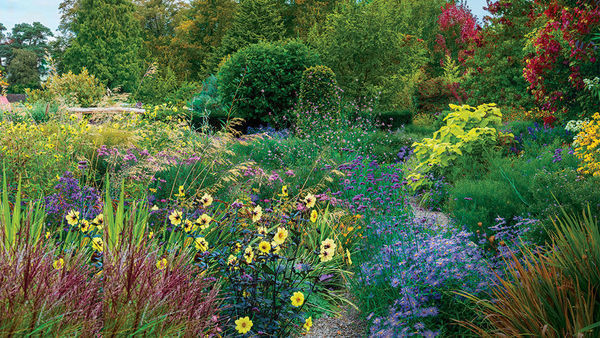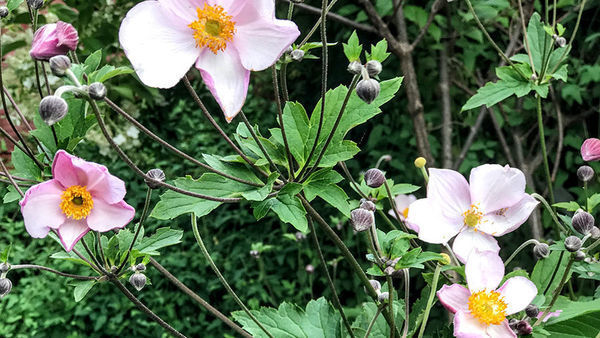
Longwood Gardens in Kennett Square, Pennsylvania, has a truly spectacular trial garden. For the past several years, this space has served as a design laboratory where the garden staff can try out new cultivars and plant combinations. The designs on display feature a colorful array of annual and tropical plants, those horticultural wonders that hit their peak from midsummer until frost.
So if your borders tend to look tired by late summer, take some inspiration from the Longwood staff. Add excitement with easygoing annuals, take your design over the top with tropicals, or test out an exciting new color combination. The trial garden designs below will help get you started, and expert tips from Longwood horticulturist Tim Erdmann will help you get the most out of your annual and tropical plants.
A fresh color story
A backdrop of burgundy and chartreuse lends a zesty new feel to bright orange zinnia and canna blooms, and a pure white dahlia adds sparkle. The overall effect is warm, inviting, and unexpected.
1. ‘Mohawk’ canna (Canna ‘Mohawk’, Zones 8–11)
2. Zowie!™ Yellow Flame zinnia (Zinnia elegans cv., annual)
3. Sweet Caroline Sweetheart Lime sweet potato vine (Ipomoea batatas ‘NCORNSP-019SCSHLM’, Zones 11–12)
4. ‘Elena’ colocasia (Colocasia esculenta* ‘Elena’, Zones 7–11)
5. ‘Starchild’ dahlia (Dahlia ‘Starchild’, Zones 9–11)
6. ‘Prince’ elephant grass (Pennisetum purpureum* ‘Prince’, Zones 8–11)
Bold blooms for shade

Most of the plants in this article thrive in full sun, but this combination was created for a bed shaded by mature hardwoods. It stars a bronze-leaved begonia and matching red geranium, balanced by a bush violet that puts out plenty of blue-violet flowers from early summer until frost. Alpine wood fern and ‘Yellow Trumpet’ cape fuchsia add soft, subtle texture to tie this vignette together.
1. Whopper® Red bronze leaf begonia (Begonia × benariensis ‘Red with Bronze Leaf’, Zones 10–11)
2. ‘Yellow Trumpet’ cape fuchsia (Phygelius aequalis ‘Yellow Trumpet’, Zones 7–9)
3. Endless™ Illumination bush violet (Browallia ‘UNHBR12’, Zones 9–11)
4. Alpine wood fern (Dryopteris wallichiana, Zones 6–9)
5. Caliente Fire® geranium (Pelargonium ‘Cante Fir09’, Zones 9–11)
Sunshine in any weather

This high-intensity combination is powered by sunny yellows. Popcorn cassia, a showy African legume, grows at least 4 to 5 feet tall with buttery yellow blooms popping from contrasting inky buds. A golden-leaved coleus carpets the ground, accompanied by a sweet yellow-flowered lantana. Tall verbena adds a touch of violet, the perfect color complement.
1. Popcorn cassia (Senna didymobotrya, Zones 9–11)
2. Luscious™ Lemonade lantana (Lantana camara* ‘Robpwcrm’, Zones 9–11)
3. ‘Solar Shade’ coleus (Plectranthus scutellarioides ‘Solar Shade’, Zones 10–11)
4. Tall verbena (Verbena bonariensis, Zones 7–10)
Three flavors of orange

Scarlet bush thrives through summer heat and produces snappy firecracker-shape flowers on reddish stems from late summer until frost. Here it is complemented by an orange-flowered lantana and a sedge that transitions from olive green to red-orange as the season progresses.
1. Scarlet bush (Hamelia patens, Zones 9–10)
2. Orange New Zealand sedge (Carex testacea, Zones 6–10)
3. Bandana® Orange lantana (Lantana camara* ‘LANZ0007’, Zones 9–11)
Turn up the volume

These large-scale plants would be perfect for screening a patio or deck. ‘Fireworks’ fountain grass offers arching blades striped in pink, deep red, white, and green. Since its purple-tinged tassels are sterile, you need not worry about unwanted seedlings. A dark-leaved taro, a spectacular cactus-flowered dahlia, and a tall single zinnia provide plenty of additional color.
1. ‘Black Magic’ taro (Colocasia esculenta* ‘Black Magic’, Zones 8–10)
2. ‘AC Ben’ dahlia (Dahlia ‘AC Ben’, Zones 9–11)
3. ‘Fireworks’ fountain grass (Pennisetum setaceum* ‘Fireworks’, Zones 9–11)
4. Zahara® XL Yellow zinnia (Zinnia marylandica ‘PAS90131’, annual)
A collection of striking specimens

Tree dahlias grow at least 8 feet tall, often taller. Since they need a very long season to flower, they are mainly grown for their lush foliage. That foliage contrasts beautifully with fernlike spires of dog fennel and the strappy, crimped leaves of Malaysian variegated palm grass. Madagascar periwinkle and a stunning red sage add a little flower power to this foliage-focused group.
1. Tree dahlia (Dahlia imperialis, Zones 9–11)
2. Malaysian variegated palm grass (Setaria palmifolia ‘Rubra Variegata’, Zones 8–11)
3. Titan Pure White™ Madagascar periwinkle (Catharanthus roseus ‘PAS420774’, Zones 10–11)
4. ‘Paul’ scarlet sage (Salvia splendens ‘Paul’, Zones 10–11)
5. ‘Elegant Feather’ dog fennel (Eupatorium capillifolium ‘Elegant Feather’, Zones 6–9)
Smoldering color from flowers and foliage

Both the flower spikes of ‘Ava’ hummingbird mint and the foliage of Brazilian Red Hots™ Joseph’s coat provide a lot of hot color over a long season. Put them together with delightfully dark-leaved black cotton and a sweet pink dahlia, and you have a combination that will wow garden guests from late summer until frost.
1. Brazilian Red Hots™ Joseph’s coat (Alternanthera dentata ‘Brazilian Red’, Zones 10–11)
2. ‘Ava’ hummingbird mint (Agastache ‘Ava’, Zones 5–9)
3. Black cotton (Gossypium herbaceum ‘Nigra’, Zones 9–11)
4. ‘Hollyhill Electra’ dahlia (Dahlia ‘Hollyhill Electra’, Zones 9–11)
Bright leaves against soft silver

‘Red Flash’ caladium has such a strong presence that it could easily clash with more colorful garden companions. But rising from a bed of silvery artemisia and spurflower, its leaves simply glow. Soft plumes of feathertop grass add another layer of irresistible texture.
1. ‘Red Flash’ caladium (Caladium ‘Red Flash’, Zones 8–11)
2. ‘Powis Castle’ artemisia (Artemisia ‘Powis Castle’, Zones 6–9)
3. ‘Silver Shield’ silver spurflower (Plectranthus argentatus ‘Silver Shield’, Zones 10–11)
4. Feathertop grass (Pennisetum villosum, Zones 9–10)
—Carol Collins is the associate editor.
Photos: Carol Collins
Fine Gardening Recommended Products

Planting in a Post-Wild World: Designing Plant Communities for Resilient Landscapes
Fine Gardening receives a commission for items purchased through links on this site, including Amazon Associates and other affiliate advertising programs.

The Crevice Garden: How to make the perfect home for plants from rocky places
Fine Gardening receives a commission for items purchased through links on this site, including Amazon Associates and other affiliate advertising programs.

Ho-Mi Digger - Korean Triangle Blade
Fine Gardening receives a commission for items purchased through links on this site, including Amazon Associates and other affiliate advertising programs.



















Comments
Log in or create an account to post a comment.
Sign up Log in